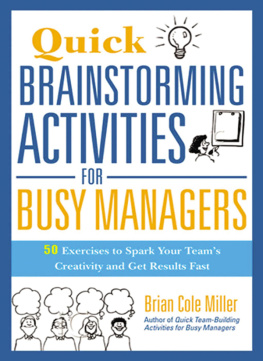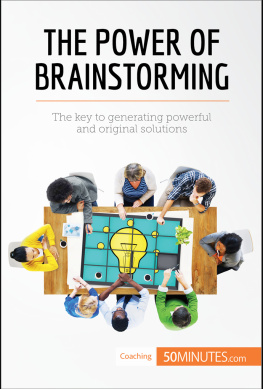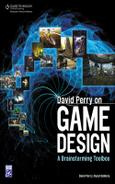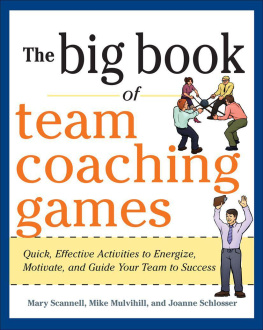Bulk discounts available. For details visit:
www.amacombooks.org/go/specialsales
Or contact special sales:
Phone: 800-250-5308
E-mail: specialsls@amanet.org
View all the AMACOM titles at: www.amacombooks.org
Includes bibliographical references and index.
1. Creative ability in business. 2. Teams in the workplace. I. Title.
2012 Brian Cole Miller.
All rights reserved.
Thank you to the many friends and colleagues who gave me encouragement for this book, as well as some great activities. This includes you Jim Fograscher, Terry Hildebrandt, Tony Lipscomb, Roshan Massey, Alejandro Rodriguez, Leigh Ann Rogers, and Scott Shaffer.
Special thank you to Mark Hansen of sparkspace in Columbus, Ohio. Your work in getting folks creative is wonderful. Thanks for sharing your techniques so freely.
Another special thank you to Michael Wilkinson of Leadership Strategies in Atlanta. Your approach to putting structure and discipline to facilitation is fantastic. Thanks for letting me use some of the brainstorming and prioritizing activities you developed.
Thank you Christina Parisi and your colleagues at AMACOM for keeping me on track, and for being patient with me when I dragged my feet.
Thank you Debbie Posner, who cleaned up my writing so well, it actually makes sense to readers now, and thanks to Mike Sivilli, who shepherded the manuscript through to finished product.
Thank you Ed Buns for the great artwork. A picture is worth 1,000 words, and your work helped save me a lot of 1,000-wordss.
Thank you Martin and David for letting me do much of my creative work at your lovely cottage in Ireland. Makes me want to write another book just so I can go back!
Thank you familyHeidee, Benjamin, Logan, Roger, Theresa, and Tinafor your ongoing support as I wrote and rewrote.
As always, thank you Tim, for the most constant and faithful support I could ever hope for.
This book is for the busy manager who uses brainstorming as a tool to gather input and ideas from his or her staff. Heres what you can expect:
Each activity takes less than 15 minutes. Brainstorming is a quick process. Part of the success comes from the tight time limits you will impose on the session. You can get great results in minimal time. Theres no need to linger on a topic until youve squeezed every last idea out of the group. Use these activities and the best ideas will flow quickly.
Each activity can be done with only a few basic materials. Most of these are things that your organization already has on hand: flip charts, markers, index cards, pens, and paper. You will need a stopwatch, but you can probably use the one on your cell phone. Other than that, the rest of the activities supply lists include things that are not difficult to obtain: large sticky pads, balloons, magazines, and so on.
Each activity has a specific, focused purpose. Some are better for large groups, some for small groups. Some draw out quieter participants. Some are competitive. Some are faster paced than others. You can pick and choose which activities you use based on the needs of your group.
Each activity can be run by you, the busy manager. They are simple to understand and easy to plan and prepare for. Some of them can even be done successfully just moments after you read them for the first time. You take this book to your meeting and use a brainstorming activity right then and there!
The outline of each activity is easy to follow. Each one is presented in the same easy-to-read bulleted format:
This is explains very briefly what the activity is.
What it does tells the benefits of the activity and what it will help you accomplish, but it also includes a word of caution about a potential downside of using the activity.
What you need tells you everything youll need for the activity. Usually, its nothing more than a marker and some flip chart paper, or a stack of index cards!
Heres how tells you, step-by-step, how to conduct the activity.
For example gives examples of things to use and/or shows how the activity may play out, so you get a good sense of what to expect. Often, there is an illustration at the end of the activity to show you how it will look on the chart or in the room when you are finished.
Tips for success includes pointers and cautions that will help you run the activity more effectively.
Try these variations offers variations on the activity that may slow it down, speed it up, expand or contract the scope, add a level of competition, or otherwise alter it for a slightly different brainstorming experience.
Relax, you wont find any of these kinds of activities here:
No touchy-feely activities in which participants have to touch each other a lot, or share personal thoughts or feelings with one another.
No outdoor activities that require large areas, nice weather, and physically fit participants.
No special handouts to prepare, copy, or distribute.
No lengthy activities during which more time is spent explaining the rules or warming the group up. Each activity takes about 15 minutes or less!
Before we get to the activities, though, there are three chapters that will help you be successful in any brainstorming session.
The first chapter explains what brainstorming is. It gives a brief history of brainstorming and some of the most common reasons for using it. Youll learn the four basic rules for brainstorming and why each is so important: focus on quantity not quality; dont allow criticism; encourage wild, outlandish ideas; combine ideas for more ideas. Then well look at the 10 steps of conducting a brainstorming sessionfrom the planning and preparation, through implementation, and on to action planning for the future. Lastly, well take a look at the most common problems that arise in brainstorming sessions. We will consider ways to prevent them from happening in the first place, but we will also discuss what to do if they happen in spite of your best efforts.











